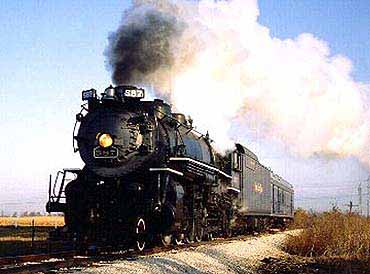 |
| USDA-NRCS. Crops in straight rows. Digital image. EQUINE LAND CONSERVATION RESOURCE. Equine Land Conservation Resource, 4 June 2013. Web. 10 Sept. 2014. |
During history class we
have been learning about industrialization. After dividing into groups, we were each given one
of the four ‘ingredients’ of industrialization and had to gather some
information about it. We did this in order to answer the question, “What was
‘revolutionary’ about industrialization?” One ingredient of industrialization
is technology. New technology made industrialization ‘revolutionary’. New
technology helped make methods of transportation much easier. The steam engine
was invented and used to power vehicles such as trains and boats. This
invention made it possible for people to travel almost anywhere across land
without the restriction of needing a body of water close by. Before steam
engines were built, trains were pulled along their tracks by horses. The steam
engine made traveling by train much quicker. Ships were also powered by steam
engines and this led to resources being shipped faster. With the steam engine,
boats were also able to travel in any weather. It no longer mattered what the weather was, the steam engine powered the boat anytime. Technology is
not the only ‘ingredient’ of industrialization. The effect of new farming
techniques made industrialization ‘revolutionary.’
 |
| Gache, Gabriel. How Steam Engines Work. Digital image. Softpedia. N.p., 14 Apr. 2008. Web. 10 Sept. 2014. |
Farmers came up with new
farming techniques to better improve the quality and quantity of farm products.
One of these techniques included the building of dikes, or giant barriers, to
shelter the land from the ocean. Farmers did this so that
the salt water from the oceans wouldn't hurt their plants. To keep the soil
full of nutrients, farmers used fertilizer and rotated crops. Farmers used
animal manure to renew nutrients to the soil. They also rotated crops so that
the nutrients in the soil wouldn't be exhausted. By keeping the soil full of
nutrients, plants became healthier and more prosperous. To further increase the
production of crops, farmers used the seed drill to plant plants in straight
lines. This technique allowed farmers to maximize their land space. Before the
seed drill, farmers would randomly scatter seeds across the land, which wasted
space. Land was also enclosed with fences to maximize land space. Pastures were
fenced for sheep, which led to an increase in wool production. As a result of
these new techniques, farmers were able to farm more land with less workers.
They were also able to produce more crops. There was now enough food so that
famine wasn't a constant fear. More food also led to an increase in population.
Not only were less people dying, but women were healthier because they had more
food and so were their babies. But because farmers weren't in need of so many
workers, peasants who formerly worked the land were forced to go to the cities
to find new work. In the cities, these people made up the labor force of the
industrial revolution. New farming techniques made industrialization
‘revolutionary’ because of the impact they had on the people at that time and
the population.
Hogwarts here we come!
ReplyDeleteHaha. I wish
ReplyDeleteShall I make up a permission slip for this outing?
ReplyDelete